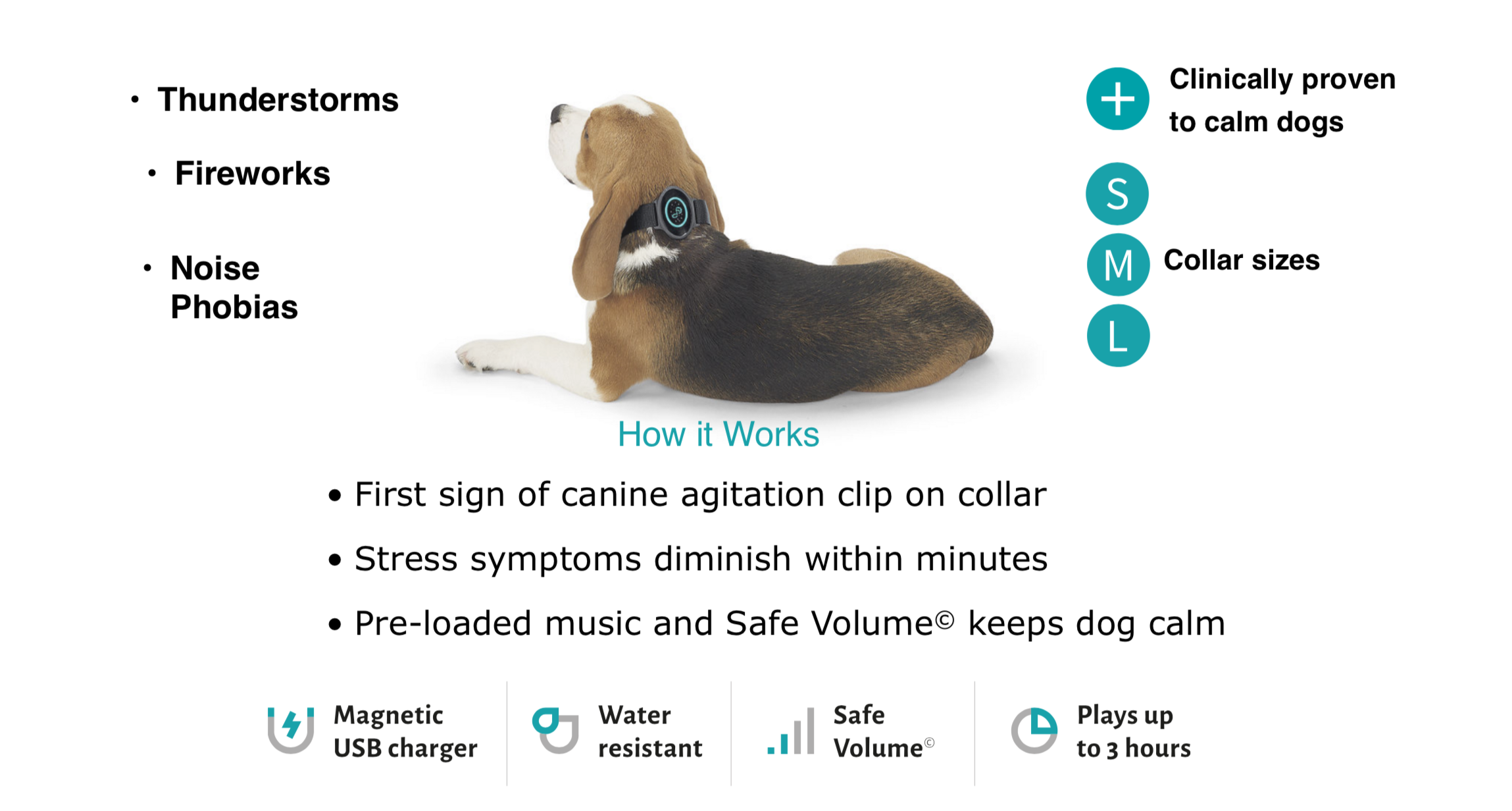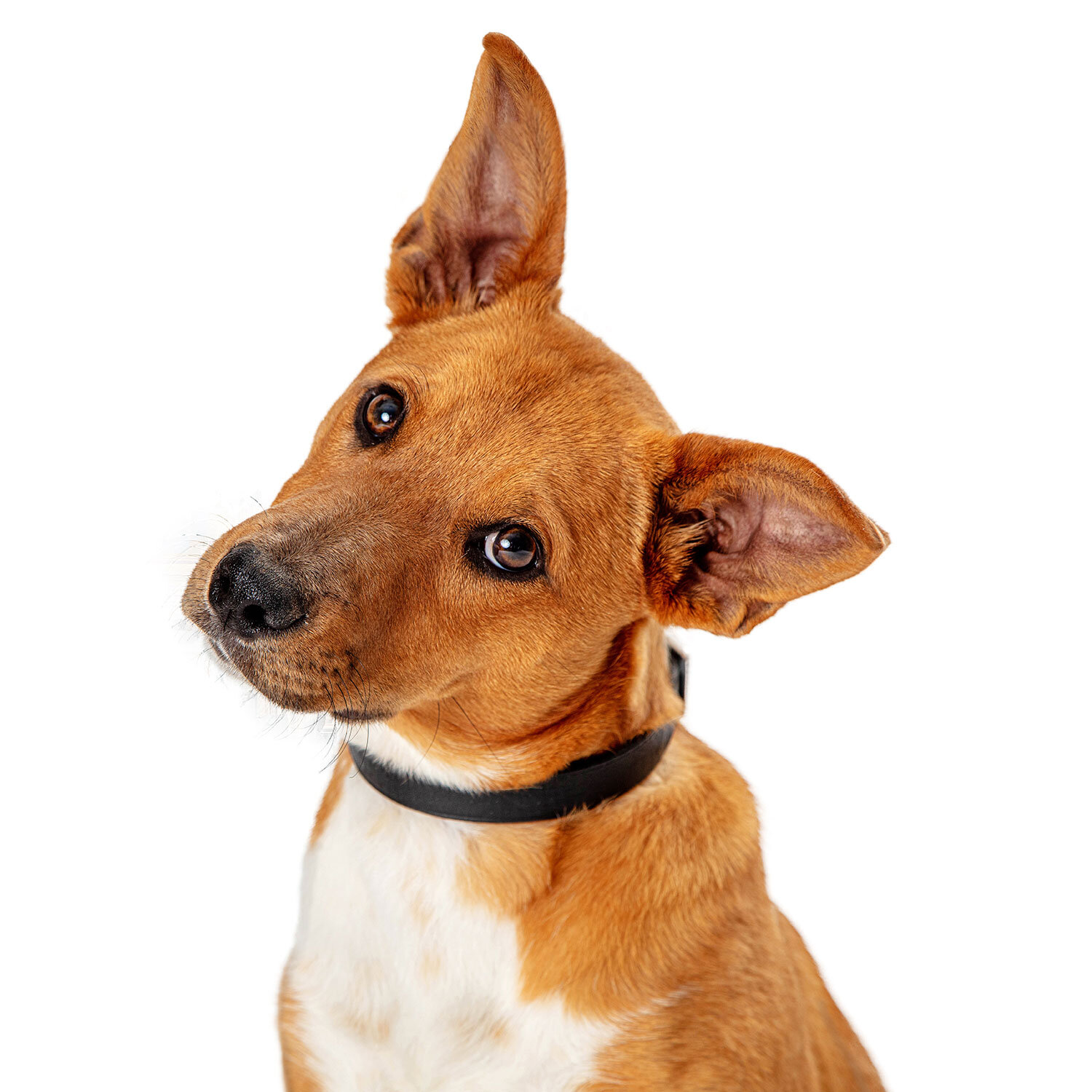Excerpts from What Dogs Hear: Understanding Canine Hearing and Behavior from Puppy to Senior by Janet Marlow, Sound Behaviorist
Thunderstorms and Fireworks
The intensity of sounds from thunderstorms is one of the most common causes of canine acute stress behaviors. Crashes of thunder and lightning strikes that we can hear, has an agitating effect on us as well. The shift in barometric pressure is an initial indicator that a storm is approaching, and it is felt by humans as well as animals. When a storm is occurring in your area, it is heartbreaking to see your wonderful dog panting, pacing and drooling in a highly anxious state. You’d like to hold your dog and help her break out of this behavior, but more often than not your loving efforts are to no avail. Dogs and cats can also suffer static shocks in the buildup to a thunderstorm. If you become nervous or anxious yourself, your dog may mirror your behavior. “There’s something about their makeup that makes their thresholds for developing this, or their ability to recover, lower than that of other animals,” says Lore Haug, DVM, a veterinary behaviorist at Texas Veterinary Behavior Services.
The decibel range of a thunderstorm is between 100 dB to 115 dB, way beyond the safety range for canine ears. Thunder also occurs in the infrasonic range (below 20 Hz), which is inaudible to humans. During a storm, pressure will occur in a dog’s ear, which is experienced as a pulsating sensation. Both ultrasonic and infrasonic sounds can be observed in the same thunderstorm. A clap of thunder can reach 120 dB. So, you can understand why a thunderstorm is an intense experience for their ears and ours.
A dog will want to escape to safety, and the shift to flight-or-fight behavior can happen quickly. Pet parents have shared with me stories of their dog jumping into a bathtub, shaking under a bed, and running right through electric fences. If a dog lives in an area that has rolling thunderstorms due to afternoon heat, the dog will develop storm phobia, which will need a behaviorist and calming tools to overcome. There are also hereditary predispositions to fear or anxiety reactive to thunderstorms, especially common in some hunting and herding breeds which includes the German Shepherd, Australian Shepherd, Labrador Retriever, Border Collie, Havanese, Shorthaired Pointer, Vizsla, and Bichon Frise.
Young dogs and senior dogs display fear of thunderstorm sounds for different reasons than adult dogs. To a young dog, storms are a new experience to learn and can be terrifying as awareness grows. Senior and geriatric dogs, whose hearing has greatly diminished, will still experience the pressure of sound by absorbing vibrations in their bodies and through their paws, which can be disorienting.
“That fear response becomes classically conditioned,” says veterinary behaviorist Lisa Radosta, who practices at Florida Veterinary Behavior Service in West Palm Beach. “Maybe the first storm isn’t traumatic, but over time the fear response becomes triggered by elements of the storm.”
To assist a young pup in desensitizing to loud noises like thunderstorms or fireworks, you can pop bubble wrap in a room where they are. First, use your Decibel App to test the loudness of the pop yourself. Have your dog smell the sheet of bubble wrap to know where the sound is coming from. Then, keeping a distance from your dog in the room, pop one bubble and stop, then say “It’s okay.” During another session, pop two bubbles and repeat saying “It’s okay.” Evaluate your pup’s response to see if it lessens reactive behavior as you increase the experience. Make sure to keep the bubble wrap away from your dog’s head and ears. Your reassurance by saying “It’s okay” will be good practice for when you and your dog are on the street and there's a loud pop sound that may startle your dog. Desensitizing your dog to street sounds, trucks and car horns is a good practice when they are young to minimize noise phobias later on.
For adult dogs, playing calming canine music will mask the thunderstorm sounds. For senior and geriatric dogs, it’s best to confine their movement to one area or room to prevent injury during agitated roaming.
Fireworks
In years past, people would gather at a large park or river shore area to enjoy a celebration with fireworks. The event would generally be coordinated by a city, town or organization and there would be a safe distance between the fireworks and the crowd of people. Now, with the availability of fireworks sold in stores for the consumer, fireworks can be heard at any time of year and as close as your neighbor’s backyard. That is fun and convenient but really bad news for dogs and cats!
Every July 4th, there are inevitably reports of dogs missing from their homes due to firework events. It is difficult to stop the flight response when there are intense sound waves close by. Due to this, dogs have run through screen doors, destroyed furniture, and fled the home for days until found.
If you are watching fireworks that are about a kilometer (1000 meters) away, the light takes only three millionths of a second to reach you. The sound takes about three seconds. Sound waves are much slower because they require a medium (mass of molecules) to travel. Fireworks produce a sound output that is in the 150 dB to 175 dB range. Fireworks generate a higher noise level than firecrackers or gunshots.
“There are three types of noises from every firework: a screeching, a whistle and a bang. Fireworks are filled with lead oxide, which turns into lead atoms as the firework explodes and heats up. Half of the narrow tube remains empty and once the firework is lit up, the empty part of the tube will vibrate and make the whistling sound.”
“In addition, firecrackers are poisonous and their explosion releases harmful particles such as fine dust (PM10) that is toxic to inhale. Therefore, fireworks represent a danger both to animals and humans who live in areas where they explode, or in relatively distant locations when the wind transports the particles. There is also a risk of ingestion of the residue of fireworks and firecrackers. The proximity animals to the areas where the firecrackers are made, often causes burns and damage to the eyes.”
As I am writing this book with a chapter about fireworks, I paid close attention this year to the local July 4th event near my home. I was shocked to discover how much my entire home vibrated from each firework explosion. I placed my hand on the walls and windows in the room where Rigby was and felt every intense vibration. Rigby was tense but he was also wearing an Ultra Calmer collar which I designed for him to ease his and other dogs for sound stress. I’d like to share how I came to invent this product device.
My passion for innovating effective tools for pet parents to resolve thunderstorm and firework stress culminated in 2016. I have talked about my beloved dog Rigby, who was my inspiration to create a solution. When Rigby was a year and half, he showed his first signs of stress due to an intense thunderstorm. It was hard to observe him pacing and being highly agitated. No amount of soft talk or touch could break his state of acute stress. That moment inspired me to invent the Ultra Calmer collar device. I spent many months thinking what would be the best device for a dog to overcome sound stress during storms and fireworks. I definitely wanted it to be easily snapped on by a caregiver, and for the dog to be able to pace or hide while wearing it. I created frequency-based music of which the Hz levels were modified for canine ears, already clinically proven to calm dogs. I developed a patent for the Ultra Calmer music device which came in three different collar sizes for small, medium and large dogs. Then, I developed a SafeVolume® Mode so that the volume level was comfortable to maintain a consistent hearing response. The product made its debut in 2016 and has helped many dogs, including my precious Rigby, ride out a thunderstorm or endure local fireworks with behavioral calm and minimal stress.
Here are two pet parent’s comments. “I bought the Ultra Calmer last fall for my golden mix, who is afraid of thunder. Yesterday, as the storms rolled through, I put it on him. There was no heavy panting, no nervous following me around. He laid down and appeared to be fine. I didn't have to give him any tranquilizers. Thank you!!!”
“Lex is terrified of fireworks. At the first boom I placed the collar with preloaded music on him and he fell asleep on the couch. Normally he's hiding in the bathroom.”
www.petacoustics.com

























